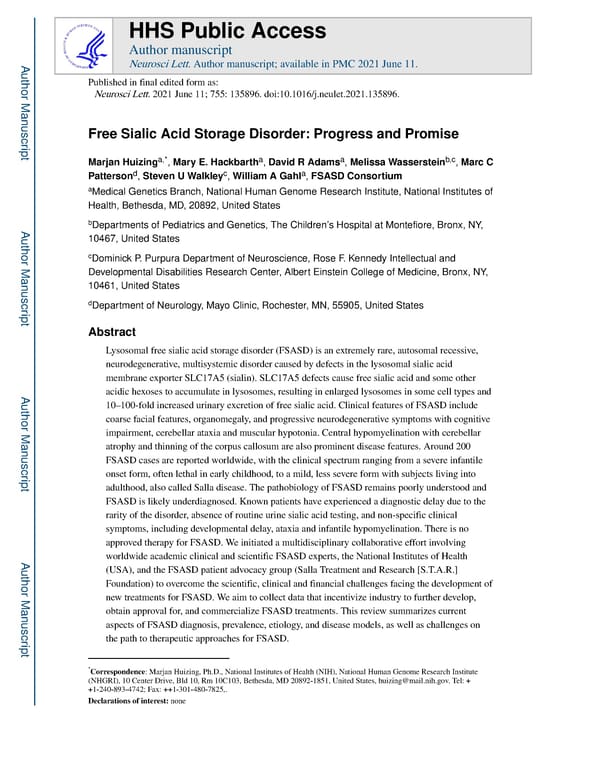Free Sialic Acid Storage Disorder: Progress and Promise
HHS Public Access Author manuscript A Neurosci Lett. Author manuscript; available in PMC 2021 June 11. uthor Man Published in final edited form as: Neurosci Lett. 2021 June 11; 755: 135896. doi:10.1016/j.neulet.2021.135896. uscr Free Sialic Acid Storage Disorder: Progress and Promise ipt a,* a a b,c Marjan Huizing , Mary E. Hackbarth , David R Adams , Melissa Wasserstein , Marc C d c a Patterson , Steven U Walkley , William A Gahl , FSASD Consortium aMedical Genetics Branch, National Human Genome Research Institute, National Institutes of Health, Bethesda, MD, 20892, United States b Departments of Pediatrics and Genetics, The Children’s Hospital at Montefiore, Bronx, NY, A uthor Man 10467, United States cDominick P. Purpura Department of Neuroscience, Rose F. Kennedy Intellectual and Developmental Disabilities Research Center, Albert Einstein College of Medicine, Bronx, NY, 10461, United States uscr dDepartment of Neurology, Mayo Clinic, Rochester, MN, 55905, United States ipt Abstract Lysosomal free sialic acid storage disorder (FSASD) is an extremely rare, autosomal recessive, neurodegenerative, multisystemic disorder caused by defects in the lysosomal sialic acid membrane exporter SLC17A5 (sialin). SLC17A5 defects cause free sialic acid and some other acidic hexoses to accumulate in lysosomes, resulting in enlarged lysosomes in some cell types and A uthor Man 10–100-fold increased urinary excretion of free sialic acid. Clinical features of FSASD include coarse facial features, organomegaly, and progressive neurodegenerative symptoms with cognitive impairment, cerebellar ataxia and muscular hypotonia. Central hypomyelination with cerebellar atrophy and thinning of the corpus callosum are also prominent disease features. Around 200 uscr FSASD cases are reported worldwide, with the clinical spectrum ranging from a severe infantile onset form, often lethal in early childhood, to a mild, less severe form with subjects living into ipt adulthood, also called Salla disease. The pathobiology of FSASD remains poorly understood and FSASD is likely underdiagnosed. Known patients have experienced a diagnostic delay due to the rarity of the disorder, absence of routine urine sialic acid testing, and non-specific clinical symptoms, including developmental delay, ataxia and infantile hypomyelination. There is no approved therapy for FSASD. We initiated a multidisciplinary collaborative effort involving worldwide academic clinical and scientific FSASD experts, the National Institutes of Health A uthor Man (USA), and the FSASD patient advocacy group (Salla Treatment and Research [S.T.A.R.] Foundation) to overcome the scientific, clinical and financial challenges facing the development of new treatments for FSASD. We aim to collect data that incentivize industry to further develop, obtain approval for, and commercialize FSASD treatments. This review summarizes current uscr aspects of FSASD diagnosis, prevalence, etiology, and disease models, as well as challenges on the path to therapeutic approaches for FSASD. ipt * Correspondence: Marjan Huizing, Ph.D., National Institutes of Health (NIH), National Human Genome Research Institute (NHGRI), 10 Center Drive, Bld 10, Rm 10C103, Bethesda, MD 20892-1851, United States, [email protected]. Tel: + +1-240-893-4742; Fax: ++1-301-480-7825,. Declarations of interest: none
 Free Sialic Acid Storage Disorder: Progress and Promise Page 2
Free Sialic Acid Storage Disorder: Progress and Promise Page 2